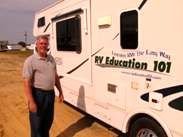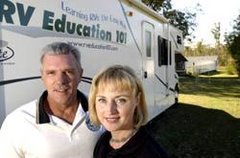The English dictionary definition for “winterize” is to prepare something, especially a house or an automobile, to withstand cold winter conditions. What I find interesting about this definition is that your RV is essentially a house and automobile combined. With that said, winterizing your RV would entail more than just preparing the water system for cold winter conditions. We would need to be concerned with preparing the RV’s interior, exterior, chassis, and plumbing from the harsh winter months.
Today I will discuss some tips for preparing the RV interior, exterior and the chassis for cold winter storage, and next week I will discuss preparing the plumbing system for the cold winter storage.
RV Interior
When RVs are stored for the winter it’s not uncommon for mice and squirrels to make their winter home in the RV. These animals are notorious for chewing through vehicle wiring, plastic and rubber components, resulting in extensive damage to the RV. If it’s a motorized RV start the engine periodically to keep any chewing squirrels out of the engine compartment area.
Possibly, the most important step is to try and prevent mice and other rodents from being able to access your RV. This can be difficult because they can enter the RV through some very small openings. Start by inspecting the underside of your RV for any gaps or holes. Fill these gaps using silicone or expanding foam. A word of caution, if you never used expanding foam before, you should experiment with it on something other than your RV first. When it dries it can expand a great deal more than you expect. Next, open drawers and cabinet doors inside your RV. Look in all of the corners and crevices, especially where plumbing and wiring enter the RV. If you can see any daylight mice can get in. Fill these areas with silicone or foam.
Remove all food from the RV when it’s being stored and thoroughly clean the RV to remove any remnants of food that might attract mice and other rodents. Some people say mothballs help deter mice from making their home in your RV, and others say an alternative to mothballs is dryer sheets, like Bounce. I have talked to people who swear they work and the smell is much more pleasant. If you are close to where your RV is being stored you may want to use conventional mouse traps and check for mice every week or so.
Next you should defrost the freezer compartment and clean the refrigerator. Leave the doors open and place baking soda in the compartments to absorb any odors. If the RV is in long-term storage, and won’t be plugged in to electricity, it’s a good idea to turn off the main breaker in the distribution panel. Turn the LP gas supply valve off at the cylinder(s) or tank. Close the window blinds to avoid sun exposure to the carpet, drapes and upholstery. Leave doors drawers and cabinets open. Clean the A/C filter(s). If you have vent covers installed on the overhead vents, that prevent rain from getting inside, leave them cracked open to allow for some ventilation. Remove any dry cell batteries from devices like smoke alarms, clocks etc.
RV Exterior
When you store your RV outside for extended periods the exterior begins to show signs of wear, caused by the constant exposure to the elements. Ozone in the air and ultraviolet, (UV) rays from the sun start to take their toll. Ozone causes the paint to fade and makes products like rubber and vinyl dry out, crack, and start to deteriorate. The UV rays from the sun make this aging process happen quicker. Before you store your RV you need to give the exterior a thorough cleaning. Whenever I’m washing or cleaning anything, whether it’s an automobile or the RV, I start from the top and work my way down. It’s a good idea to clean the RV roof before putting the RV in storage too. The type of roof your RV has will determine the cleaner you will need to use. Wash the exterior and if you’re really motivated wax it, using a quality wax formulated for the type of exterior surface your RV has. A good coat of wax protects your RV finish the same as it does an automobile. When you are cleaning the RV exterior inspect all roof seams, body seams and window sealant for any cracks and openings that would allow water to get in. Consult your RV dealer for sealants compatible with these materials and re-seal as required.
Don’t forget to clean the awning fabric, and let it dry completely before storing it. If you have a pop-up or hybrid trailer make sure all of the tenting material is clean and dry before storage.
Ideally you should try to store your RV under a covered area and on a solid surface like concrete. If this isn’t possible avoid parking under trees and in tall grass, fields or wooded areas. If the RV won’t be parked under some type of covered shelter you may want to invest in a cover. Covering your RV can be a logical and cost effective way to help protect your investment. If you decide to use a cover make sure it is made of a breathable material.
Service all locks with a spray lubricant and lubricate all hinges. Insects are attracted to the odorant added to LP gas. You may want to cover LP gas appliance vents to prevent insects from making their winter home inside these vents. If you do cover the vents, remember to remove the cover next spring.
RV Chassis
Just like the exterior of the RV, the tires on your RV can be damaged by the harmful UV rays from the sun. Inflate the tires to the manufacturer’s recommended pressure and cover the tires with covers that will block out the sunlight. Place something like a piece of wood between the ground and the tires. Frozen ground and petroleum based surfaces, like asphalt, can damage tires over time. Make sure that whatever you use to block the tires is larger than the footprint of the tire. No portion of the tire should hang over the edge of the tire block; this can cause internal damage to the tire. For trailers, chock the wheels front and rear. If you are storing a pop-up outdoors angle the tongue downward to assist in snow and water run-off.
Battery maintenance is an important part of winter storage preparation. If you plan to start the unit while in storage, and to periodically plug the unit into shore power leave the batteries in the unit. Plugging it into shore power once a month for about eight hours will help keep the coach batteries topped off. At a minimum you should check and adjust the water levels in all batteries and make sure the batteries are fully charged. A discharged battery will freeze much quicker than a fully charged battery. If the RV is in long-term storage it’s better to remove the batteries and store them where they will not freeze. In either case keep the batteries fully charged when they are in storage.
Note: If your converter charger doesn’t have a three stage charging system (or storage maintenance mode) don’t leave the unit plugged in constantly. This could overcharge the batteries and deplete the electrolyte levels.
If it’s a motorized RV you should fill the fuel tank prior to storage and add a fuel stabilizer. Run the engine and the generator long enough for the stabilizer to get through the entire fuel system. Change the oil and oil filter on the engine and the generator prior to storage. Acids accumulate in used oil and can corrode engine bearings, especially while sitting for long periods of time. If possible exercise the generator for at least two hours every month with a minimum of a ½ rated load on it. Consult your generator owner’s manual for load ratings.
Winterizing Part 2: How to prepare the RV plumbing system for the cold winter months.
If you would like to learn more about winterizing & storing your RV check out our Winterizing & Storing your RV ebook
and Winterizing and Storing Your RV video
Happy Camping,







No comments:
Post a Comment